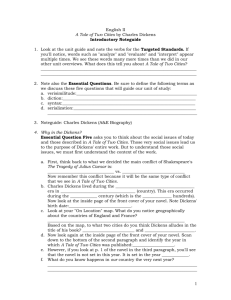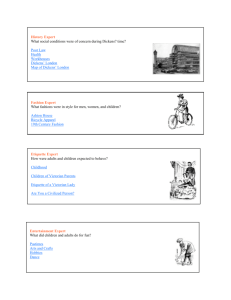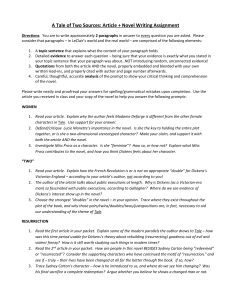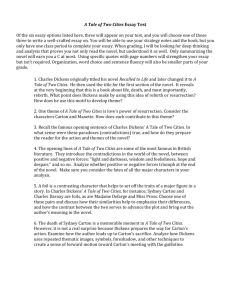Tale of Two Cities Notes
advertisement
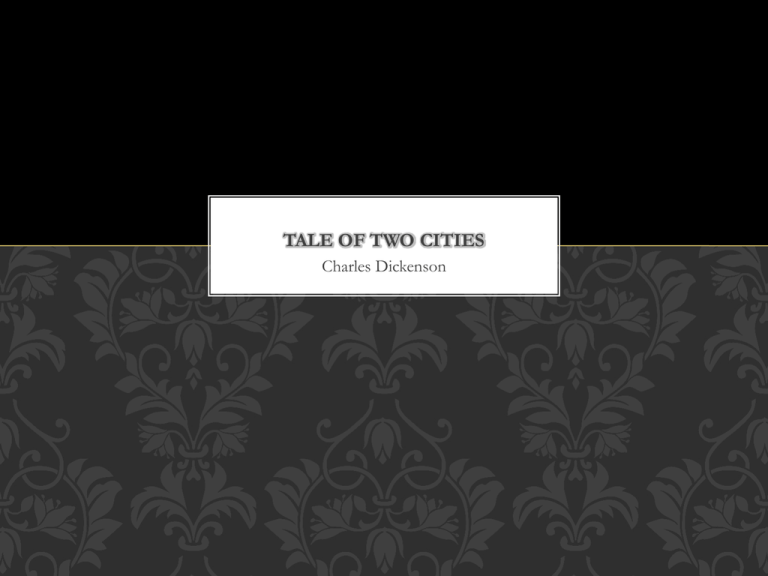
TALE OF TWO CITIES Charles Dickenson MEET CHARLES DICKENS - Born in Portsmouth, England - - Lower middle class family Moved several times as a young person due to financial troubles with his father finding a job. - Dickens father was eventually imprisoned for debt in London’s prison. Dickens was sent to work in a shoe polish factory to bring in income because of this. - This event “scarred” Dickens and is often referred to in his writing. - He held a sympathy for the poor because of these events. DICKENS THE WRITER Serial publication of Pickwick Papers began in 1836. Dickens became in overnight success. Dickens was the most popular author of his time. His works: Oliver Twist Tale of Two Cities Hard Times David Copperfield Great Expectations Barnaby Rudge A Christmas Carol DICKENS ADULT YEARS… - - He was married with 10 children. - Worked on causes to improve education, and acted in plays. - Traveled widely and did reading tours. In 1869 during one of these tours his health failed and he returned home. - He died while working on The Mystery of Edwin Drood - He is buried in the poets corner of West Minster Abbey. TALE OF TWO CITIES A Tale of Two Cities was published in 1859. Dickens was most popular author of his time. Was dismayed at social inequality in British society. “It was the best of times, it was the worst of times…” While it was the best of times for England’s wealthy, with their town homes and country estates, Dickens believed that times had never been worse for the nations poor. During the novel he had met and fallen in love with Ellen Ternan who they believe is the model for the character Lucie Manette. TAL E OF TWO CITIES Novel was published serially in weekly or monthly installments in popular magazines. The installment usually included one or two chapters and an illustration of an important or dramatic scene. Novel published in book form after serial was finished. A Tale of Two Cities was the first serial to be published in his own new magazine. The serial form required a “cliffhanger” at the end of each chapter. Why? A TAL E OF TWO CITIES The novel tells of people whose lives are interrupted or wasted, then reawakened with new purpose. Several of the characters are symbolic representations of ideas rather than real-life individuals. It’s rich in detailed descriptions. Tale of Two Cities has been filmed many times. Dickens hoped to create the historical events of the French Revolution understandable. TIME & PLACE The action of A Tale of Two Cities takes place over a period of 18 years. It is told in a flashback. The key events take place just before and during the French Revolution. Novel is set mostly in London and Paris FRENCH REVOLUTION One of the most important events of 1700’s The revolution began in 1789 with an attack on the notorious prison, the Bastille. (key event in story). Several people were elected throughout the revolution in France, but many resorted to terrorism to defeat their political opponents. Kings were worried that thrones were in jeopardy. Some political leaders threatened to over throw the current government. Many of the events in Tale of Two Cities are real life events. The book is meant to depict the cruelty and poverty the French poor had to endure at the hands of the corrupt nobility. 4 REASONS THE REVOLUTION OCCURRED 3. 1. France could not produced enough food to feed its people. 2. The newly wealthy middle-class was without political power Peasants hated the ancient feudal system in which they were forced to work for local nobles. 4. New ideas about social and political reform were spreading FRENCH REVOLUTION VIDEO French Revolution Documentary JOURNAL TAL E OF TWO CITIES #1 Describe a time in life in which is was the best of times and also the worst of times like Dickens describes in the opening of the novel. INTRODUCTION OF TALE OF TWO CITIES Oprah Introduction of Tale of Two Cities ALLUSION An implied or indirect reference in literature to a familiar person, place or event. Examples: • “Beam me up Scotty”! • “May the force be with you”! • “Boom goes the dynamite”! WHY USE ALLUSIONS? If the audience is familiar with the event or person, they will also know background and context. Thus, just a few words are enough to create a certain picture (or scene) in the readers’ minds. The advantages are as follows: - We don’t need lengthy explanations to clarify the problem.- The reader becomes active by reflecting on the analogy. - The message will stick in the reader's mind. ALLUSION EXAMPLES Examples: The Scrooge Syndrome (allusion on the rich, grieve and mean Ebeneezer Scrooge from Charles Dicken’s “Christmas Carol”) The software included a Trojan Horse. (allusion on the Trojan horse from Greek mythology) ALLUSION EXAMPLE "Christy didn't like to spend money. She was no Scrooge, but she seldom purchased anything except the bare necessities". Did you spot the allusion to Scrooge? That name should bring to mind an image of someone who 'pinches pennies' and hoards money with a passion. But the allusion only works if the reader is familiar with Charles Dickens' story 'A Christmas Carol'. ALLUSION VIDEO & ACTIVITY Allusion Video Allusion Comic Exercise DIALOGUE In its widest sense, dialogue is simply conversation between characters or speakers in a literary work; in its most restricted sense, it refers specifically to the speech of characters in a drama. “ ‘Quotations are often used in writing to off set that a character is speaking out loud” said Mrs. Fuggiti. ‘ “ A quote from a novel would be in quotations as well, but a quote does not have to be dialogue. It can be ANYTHING! We will be working on quote analysis throughout unit, please keep this in mind. DIALECT A regional or social variety of a languages distinguished by pronunciation, grammar, or vocabulary, especially a way of speaking that differs from the standard variety of the language. An accent is the way that particular person or group of people sound. It’s the way somebody pronounces words, the musicality of their speech, etc. A dialect describes both a person’s accent and the grammatical features of the way that person talks. DIALECT EXAMPLES Examples: Ya’ll Hero vs. Sub vs. Hoagie Soda vs. Pop Needs done I’ll grab the cereal awhile Yous guys Real quick Take a shower DICTION Diction can be defined as style of speaking or writing determined by the choice of word by a speaker or a writer. Individuals vary their diction depending on different contexts and settings. It may be “formal” where formal words are used in formal situations: - press conferences -presentations - school We use “informal” diction in informal situation: - letters to a friend - texting - e-mail “Slang” is the use of words that are impolite and newly coined. JOURNAL # 2 Examine the way that Jerry Cruncher speaks versus some of the other characters in the story. How is this an example of dialect? What does it say about the character Jerry Cruncher? FIGURATIVE LANGUAGE Language that cannot be taken literally since it was written to create a special effect or feeling. It often will imply a meaning or provoke emotion There are 7 categories of figurative language. Imagery Simile Metaphor Alliteration Personification Onomatopoeia Hyperbole IMAGERY Language that appeals to the senses. Most images are visual, but they can also appeal to the senses of sound, touch, taste, or smell. Then with cracked hands that ached from labor in the weekday weather . . . from “Those Winter Sundays” SIMILE A comparison of two things using “like, as than,” or “resembles.” “She is as beautiful as a sunrise.” METAPHOR A direct comparison of two unlike things “All the world’s a stage, and we are merely players.” - William Shakespeare EXTENDED METAPHOR A metaphor that goes several lines or possible the entire length of a work. IMPLIED METAPHOR The comparison is hinted at but not clearly stated. “The poison sacs of the town began to manufacture venom, and the town swelled and puffed with the pressure of it.” - from The Pearl - by John Steinbeck ALLITERATION Consonant sounds repeated at the beginnings of words If Peter Piper picked a peck of pickled peppers, how many pickled peppers did Peter Piper pick? PERSONIFICATION A figure of speech in which an animal, object, or idea is given human form or characteristics. Dickens was a master of this technique and often used it to help create striking descriptions or moods in his novels. Chapter 5: The concept of hunger is described as “staring down from the chimneys of the poor and rattling its dry bones”. Chapter 9: He uses personification to describe a Nobel's castle. By making the castle itself seem to comment on the action, Dickens does not have to express directly his own feelings about the noble. ONOMATOPOEIA Words that imitate the sound they are naming BUZZ BOOM BANG ZAP SNAP, CRACKLE, POP THRONG OR sounds that imitate another sound HYPERBOLE A hyperbole is an extreme exaggeration used to make a point. It is like the opposite of “understatement.” It is from a Greek word meaning “excess.” -I am so hungry I could eat a horse. -I have a million things to do. -I had to walk 15 miles to school in the snow, uphill. -I had a ton of homework. -If I can’t buy that new game, I will die. HYPERBOLE IN LITERATURE A great example of hyperbole in literature comes from Paul Bunyan’s opening remarks in the American folktale Babe, the Blue Ox: “Well now, one winter it was so cold that all the geese flew backward and all the fish moved south and even the snow turned blue. Late at night, it got so frigid that all spoken words froze solid afore they could be heard. People had to wait until sunup to find out what folks were talking about the night before.” HYPERBOLE IN LITERATURE "As I Walked Out One Evening" by W.H. Auden: "I'll love you, dear, I'll love you till China and Africa meet, And the river jumps over the mountain And the salmon sing in the street, I'll love you till the ocean Is folded and hung up to dry And the seven stars go squawking Like geese about the sky." JOURNAL # 3 Find an example of figurative language in “The Tale Of Two Cities”. Be sure to explain what type of device is being used. Why might Dickens have used figurative language in this instance? FILMS AND CARTOONS DEFINITION OF SATIRE…. A literary work that ridicules its subject through the use of techniques such as exaggeration, reversal, incongruity, and/or parody in order to make a comment or criticism about it. Matrix Clip EXAGGERATION -To enlarge, increase, or represent something beyond normal bounds so that it becomes ridiculous and its faults can be seen -Example: Princess Fiona fights and successfully defeats Robin Hood and all of his Merry Men without any help and without any weapons. -The pauses during the fight are exaggerated - REVERSAL To present the opposite of the normal order (e.g., the order of events, hierarchical order). Shrek Matrix Clip Example: The roles of the hero and the damsel in distress have been reversed. In this clip, it is Princess Fiona, the rescuee, who fights and defeats the foe. INCONGRUITY To present things that are out of place or are absurd in relation to its surroundings. Example: Princess Fiona uses her ponytail to deliver a knockout punch to one of the Merry Men. While frozen in a mid-air martial arts kick, Princess Fiona pauses to fix her disheveled hair before knocking out two of the Merry Men. PARODY To imitate the techniques and/or style of some person, place, or thing. Matrix Parodies CRITICISM ABOUT SOCIETY? The traditional story of the knight rescuing the damsel-indistress is not a realistic depiction of the roles filled by men and women in modern society. Example: Current Hollywood action movies like The Matrix have become ridiculous because they are too focused on special effects. UNIVERSAL CHARACTER A character that symbolically embodies well-known meanings and basic human experiences, regardless of when or where he/she lives. 1) Hero (think of the classic hero journey & qualities of hero) “The main character leaves his or her community to go on an adventure, performing deeds that bring honor to the community” (Herz and Gallo 121). 2) Mother figure Fairy Godmother (surrogate mother)—comforts and directs child, especially when he or she is confused and needs guidance. Represents powers that can be called on for help when it is needed. Helps young person to solve own problems (Knapp 71 Earth Mother Stepmother- 3) The great teacher/mentor Wise old men/women—protects or helps main character when he or she faces challenges. UNIVERSAL CHARACTER 4) The innocent: Child/Youth Inexperienced adult 5) Underdog: 6) Double: Split personality—the other side of an individual UNIVERSAL SIGNIFICANCE The generally accepted importance or value of work to represent human experience regardless of culture or time period. These books often comment on: 1) Politics 2) Society 3) Religion 4) Universal Characters that socially impact the world UNIVERSAL SIGNIFICANCE POLITICS These books represent some of the most important works that examine politics, economics, and philosophy that affect government. 1) The Rights of Men by Thomas Paine: Paine’s book states that the government’s role is to protect the rights of its citizens, and when the government cannot do so, it should be overthrown. This book was written to defend the French Revolution and was an inspiration for democracy around the world. 2) Uncle Tom’s Cabin by Harriot Beacher Stowe: Written by a middle aged, white woman in 1851, Uncle Tom’s Cabin has been credited for changing the views of slavery in the north and continues to serve as a reminder of the effects of slavery and other inhumane acts. UNIVERSAL SIGNIFICANCE SOCIETY 1) Diary of A Young Girl by Anne Frank: This landmark book details the days of a Jewish family in hiding during the Nazi takeover in the Netherlands. The innocence of this young girl so full of hopes and dreams is in sharp contrast to the reality of her ending at the hands of the Nazis. This book has become a symbol and reminder against racial persecution. 2) Walden by Henry David Thoreau: Thoreau underwent an experiment of living isolated on Walden Pond in order to better understand society. He wrote the results of this experience in Walden, which has subsequently become a source of inspiration for those seeking a simpler, more self-sufficient life. UNIVERSAL SIGNIFICANCE RELIGION 1) The Bible: This sacred text brought Christianity to the world and has continued to serve as a source of inspiration for millions of people. It is the most translated and the most frequently purchased book in the world. 2) Other Religious Texts: UNIVERSAL SIGNIFICANCE SOCIALLY Characters and stories that have become ingrained in cultures around the world to upsetting censorship to inspiring the imagination of many, these works of literature have all touched the world in significant ways. 1) A Christmas Carol by Charles Dickens: From the time this book was first published in December of 1843, it has enjoyed enormous popularity. During the time that Dickens’ wrote the story, Christmas traditions were going out of style. He is often credited with saving the old traditions of Christmas. 2) A Brave New World: Often considered one of the great novels of the 20th century. Huxley’s novel looked unfavorably on the loss of an individual’s identity through technological advancements. Some of the developments Huxley wrote about have become startlingly accurate as the future he predicted in 1931 has come closer to reality. JOURNAL 4 What kind of universal characters or universal significance are within the novel Tale of Two Cites? Explain how this is evident. SYMBOLISM When a person, place, thing, or event that has meaning in itself also represents, or stands for, something else. = = = Innocence America Peace A symbol is anything that hints at something else, usually something abstract, such as an idea or belief. A literary symbol is an object, a person, a situation, or an action that has a literal meaning in a story but suggests or represents other meanings. Define: Ex: A general symbol is universal in its meaning. Even if the symbol were removed from a work of literature, it would still suggest a larger meaning. Ex: While the sea symbolizes the universal voyage from life to death in The Odyssey, it retains this association independent from literature. The "sea" is a general symbol. Ex: In poetry, a "rose" often is not only a flower, but also a general symbol for romantic love. A specific symbol is not universal in its meaning. It acquires a specific meaning based on how it relates to the content of a novel, poem, etc. The symbol's significance exists only within the context created by the author. Ex: A hunting cap in The Catcher in the Rye has no universal meaning, but within the novel it is worn backwards and symbolizes a looking back at childhood. Ex: A pair of eyes on a billboard in the Great Gatsby has no universal meaning, but within the story symbolizes the eyes of God watching humanity. To be called a symbol, an item must suggest a meaning different in kind from its literal meaning; a symbol is something more than its class or type. A symbol may have more than one meaning. This does not mean that the symbol can mean anything you want it to because possible meanings are always controlled by the context. To identify a symbol, note if an object seems to: 1) Appear repeatedly have an unusually vivid quality 2) Described with language conveying much emphasis 3) Have more significance than its literal reality would suggest 4) Consistent! Carefully examine how the symbol functions in relation to the story. Ask yourself what idea is represented by the symbol. Classification may reveal opposite relationships, such as symbols of good and evil, life and death. Or symbols may fall into isolated categories, such as destruction or innocence. Determine how much depth a particular symbol has and classify its possible meanings. While you may focus on only one major symbol, you may be able to divide it into two specific meanings and two general meanings. Remember: A symbol has a literal meaning in a story but suggests or represents other meanings. Not all symbolism is obvious; often it is subtle and indirect. American Beauty Clip In the clip American Beauty what kind of descriptions are used to describe the plastic bag? What does the plastic bag mean to the male character? Based on the description of the plastic bag and what the plastic bag appears to mean to the male character, what would you predict that the bag symbolizes throughout the film? MOTIF A motif can be an element or idea that repeats throughout that piece of literature. A motif could be expressed by a collection of related symbols. For example, the motif of fragmentation (of a family, for instance) could come from several symbols that appear in a book: shattered glass an unfaithful spouse a runaway (pet, teen, car) Sometimes a motif can be a contrast, like "light and dark." A series of symbols that could represent this motif might be: moon shadows (shades of darkness) a candle (a light in the darkness) storm clouds (temporary darkness) a ray of sunshine (emerging from darkness) a tunnel (through the darkness) ALLEGORY Writers use allegory to add different layers of meanings to their works. Allegory makes their stories and characters multidimensional, so that they stand for something larger in meaning than what they literally stand for. Allegory allows writers to put forward their moral and political point of views. A careful study of an allegorical piece of writing can give us an insight into writer’s mind as how he views the world and how he wishes the world to be. An allegory is a type of extended metaphor! ALLEGORY EXAMPLES “Animal Farm”, written by George Orwell, is an allegory that uses animals on a farm to describe the overthrow of the last of the Russian Tsar Nicholas II and the Communist Revolution of Russia before WW II. The actions of the animals on the farm are used to expose the greed and corruption of the revolution. It also describes how powerful people can change the ideology of a society. One of the cardinal rules on the farm for the animals is: The animals on the farm represent different sections of the Russian society after the revolution. For instance, “Pigs” represents those who came to power following the revolution; “Mr. Jones” the owner of the farm represents the overthrown Tsar Nicholas II, while “Boxer” the horse, represents the laborer class etc. Allegory in the novel allows Orwell to make his position clear about the Russian Revolution and expose its evils. ALLEGORY VS. SYMBOLISM An allegory involves using many interconnected symbols or allegorical figures in such as way that in nearly every element of the narrative has a meaning beyond the literal level, i.e., everything in the narrative is a symbol that relates to other symbols within the story. The allegorical story, poem, or play can be read either literally or as a symbolic statement about a political, spiritual, or psychological truth. IRONY The use of a word or phrase to mean the exact opposite of its literal or usual meaning; incongruity between the actual result of a sequence of events and the expected result. IRONY: THE USE OF WORDS TO CONVEY A MEANING THAT IS THE OPPOSITE OF ITS LITERAL MEANING Verbal Irony: Examples: “clear as mud” "as much fun as a root canal. Situational Irony - Situational irony results from recognizing the oddness or unfairness of a given situation, be it positive or negative. Examples: Bill Gates win’s a computer contest Dramatic Irony: when the words and actions of the characters of a work of literature have a different meaning for the reader than they do for the characters. Examples: “The Quiet Man” Shawn Kelvin who wants to avoid conflict, is a prize fighter. Big Liam of course doesn’t know this. Alanis Morissette: Isn't it ironic INTERPRET To give reasons through an explanation. To convey and represent the meaning or understanding of a text. All of these elements in this unit contribute to your ability to interpret what you read. Your quote analysis will also demonstrate your ability to interpret significant elements of a text. QUOTE ANALYSIS CP: One quote analysis (formal typed paper) will be completed at the end of the novel Tale of Two Cities. We will be peer editing and turning them in for a grade. Honors: Quote Analysis Number 3

